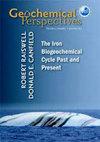碳捕集与封存:从全球循环到全球解决方案
IF 2.5
3区 地球科学
Q1 GEOCHEMISTRY & GEOPHYSICS
引用次数: 0
摘要
人为碳排放已经超过了自然碳循环,导致大气中二氧化碳浓度急剧增加。这种增长速度可能是地球历史上前所未有的,并正在导致全球气温大幅上升、海洋酸化、海平面上升以及潜在的人类健康挑战。在这篇地球化学展望中,我们回顾了自然碳循环及其与全球气候的联系。值得注意的是,正如本卷总结的实地观测直接观察到的那样,在全球温度上升、大陆风化率和二氧化碳之间存在一个自然的负反馈循环,这一循环倾向于在地质时间尺度上限制地球气候变化。由于大气中碳浓度的迅速增加,自工业革命开始以来,全球平均气温上升了1.2°C以上。减缓甚至阻止全球平均气温上升的一种方法是通过碳捕获和储存(CCS)。二氧化碳既可以从大型工业点源捕获,也可以直接从大气中捕获。考虑到自然碳循环,储存捕获的二氧化碳最安全的方法是将其与基性或超基性岩石反应形成稳定的碳酸盐矿物,这一过程被称为“矿物碳酸化”。虽然矿物碳酸化可以在地球表面发生并加速,但由于所需的规模和所需的时间框架,它在地下最有效。通过一项名为CarbFix的学术-工业合作,这种地下矿化方法发展成为一种工业规模的工艺。详细介绍了CarbFix的历史,从它作为一个概念的开始,到它作为一个工业过程的安装。《地球化学展望》最后评估了地下矿化作为应对全球变暖挑战的一种手段的未来,并详细列出了需要解决的潜在研究方向,以进一步提升和优化这种碳储存方法。本文章由计算机程序翻译,如有差异,请以英文原文为准。
Carbon Capture and Storage: From Global Cycles to Global Solutions
Anthropogenic carbon emissions have overwhelmed the natural carbon cycle, leading to a dramatic increase in atmospheric CO2 concentration. The rate of this increase may be unprecedented in Earth’s history and is leading to a substantial increase in global temperatures, ocean acidification, sea level rise and potentially human health challenges. In this Geochemical Perspectives we review the natural carbon cycle and its link to global climate. Notably, as directly observed by field observations summarised in this volume, there is a natural negative feedback loop between increasing global temperature, continental weathering rates, and CO2 that has tended to limit Earth climate changes over geological time scales. Due to the rapid increase in atmospheric carbon concentrations, global average temperatures have increased by more than 1.2 °C since the start of the industrial revolution. One way to slow or even arrest this increasing global average temperature is through Carbon Capture and Storage (CCS). Carbon dioxide can be captured either from large industrial point sources or directly from the atmosphere. Taking account of the natural carbon cycle, the most secure approach to storing captured CO2 is by reacting it with mafic or ultramafic rocks to form stable carbonate minerals, a process referred to as “mineral carbonation”. Although mineral carbonation can occur and be accelerated at the Earth’s surface, due to the required scale and required time frames it is most effective in the subsurface. This subsurface mineralisation approach was developed into an industrial scale process through an academic-industrial collaboration called CarbFix. The history of CarbFix, from its beginnings as a concept through its installation as an industrial process is presented in detail. This Geochemical Perspectives concludes with an assessment of the future of subsurface mineralisation as a means to help address the global warming challenge, as well as a detailed list of potential research directions that need to be addressed to further upscale and optimise this carbon storage approach.
求助全文
通过发布文献求助,成功后即可免费获取论文全文。
去求助
来源期刊

Geochemical Perspectives
GEOCHEMISTRY & GEOPHYSICS-
CiteScore
0.80
自引率
0.00%
发文量
1
期刊介绍:
Each issue of Geochemical Perspectives presents a single article with an in-depth view on the past, present and future of a field of geochemistry, seen through the eyes of a highly respected member of our community. The articles combine science and history of the field’s development and the scientist’s opinions about future directions. We expect personal glimpses into the author’s scientific life, how ideas were generated, pitfalls and triumphs along the way, and how ideas were adopted to carry our field further. Perspectives articles are intended for the entire geochemical community, not for experts. They are not reviews or monographs or text books. They go beyond the current state of the art, providing opinions about future directions and impact in the field.
 求助内容:
求助内容: 应助结果提醒方式:
应助结果提醒方式:


